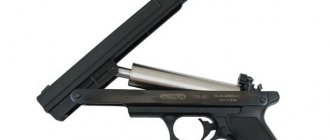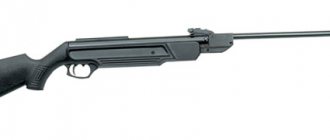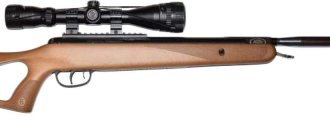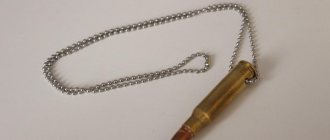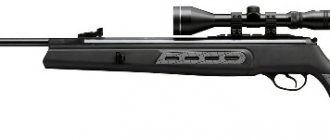Use of pneumatics in Russia
There is an unspoken opinion among people that the use of air guns for hunting is prohibited by law in our country. This is wrong. In hunting areas it is allowed to kill crows and predators without the appropriate permit. The law stipulates only the methods of their extermination. The use of air rifles is not prohibited for such situations .
However, federal law requires a permit to be obtained when hunting wild game. Any owner of a pneumatic gun with a power of more than 25 joules has no right to use a rifle for slaughtering animals. This information is specified in the thirteenth article of the law “On Weapons”.
Permit for air guns
Less powerful pneumatics do not require a permit, but it is not advisable to use them for hunting purposes. This is especially true for an air rifle, which has an energy of only 7.5 joules. By law, possession of a certified weapon of this type is permitted, but its use inappropriately is punishable. In addition to the above, the law also requires a hunting license.
Currently, the most popular type of air gun is the 4.5 mm rifle with a power of 7.5 joules. They are easy to purchase without breaking the law and convenient to use for shooting rats, crows and others.
However, large-caliber pneumatics are in increasing demand every year. They are great for hunting hare, beaver, wild boar and other animals of this class. While rifles with low power ratings are used for killing birds, such as ducks, hazel grouse, pheasants, partridges or crows. In this case, the shot must be fired at the closest possible distance, since a distance over 50 meters significantly affects the characteristics of the shot.
How to hunt a wild boar. Precautionary measures
- It is recommended, if possible, to position yourself for shooting near a tree, stump or boulder, in order to use it as a shelter in case of threat;
- Remember that an old boar can rush at a hunter without even being wounded. Never shoot at a boar with a bayonet; it is better to let it pass and hit it in the side or along the ridge to steal it. The best shots are under the ear and under the front shoulder blade;
- Chasing a wounded boar is always dangerous. In these cases, he gets into the very stronghold, hides and, as a rule, rushes at a suitable hunter. You can dodge his throw by jumping to the side. Having run past, the boar rarely repeats its attack. An accidental fall of a hunter in this situation usually ends tragically;
- Never start tracking a wounded boar at dusk, and also do not let two dogs follow the trail at once, as when paired they lose caution;
- Approach the fallen boar from the side or rear with your gun ready to fire. It is strictly prohibited to approach a wounded animal from the front! Often a seemingly dead boar is still alive and has enough strength to charge at the approaching hunter. Therefore, as you approach, you need to take a closer look at the animal: if the ears are flattened and the stubble on the back of the neck stands on end, then the animal is still alive and dangerous. In any case, without getting too close, take a control shot in the ear.
Rifle selection
Since each type of pneumatics has its own characteristic features, a number of indicators must be taken into account when choosing. The law plays an important role here. If you don't have a high-powered weapon permit, you won't be able to use high-performance airguns.
To hunt wild boar, beaver, hare and others, you need a rifle with high muzzle energy. A great example is the Korean "Dragon Career Slayer". However, such pneumatics are prohibited by law in our country, so they can only be used abroad .
Career Dragon Slayer Air Rifle
Compression and spring-piston rifles are especially popular. They function in the cold season, which is very important for our climate. The most in demand are pneumatics from German and Spanish manufacturers. Compressor rifles are much more expensive, however, the demand for them is much higher. This is due to the technical characteristics of single and multiple inflation of compression pneumatic weapons.
A cheap option is pneumatics with a spring-piston system. Suitable for hunting pheasants, partridges, ducks, hazel grouse, crows and other birds, as well as small animals such as hare or beaver. However, this design has a drawback - after each shot you must manually reload the rifle.
Spring-piston pneumatics Storm-XT
Therefore, for wary game such as ducks or hares, it is necessary to take an accurate first shot. Otherwise, you will scare the animal away and it will be difficult to find. Moreover, spring-piston rifles allow hunting only at close range. Because of this, it is not recommended to go with such a weapon against wild boar and larger game, as it is quite dangerous.
One of the most popular brands of air guns is Pre-Charge Pneumatics or PCP. Many rifles from this manufacturer can fire up to 45 shots without reloading. In addition, they are very light and comfortable. True, their cost is significantly higher than alternative rifles. PCPs are designed for professional hunters.
Air rifle Pre Charge Pneumatic
Winter is ending, it's time to take stock of the winter hunting season. Everyone has their own results... I remember this winter as December, when my friend Sasha and I decided to go to close the autumn-winter hunting season - to hunt animals in the hunting grounds in the western center. area, stopping at a hunting base. In general, at the end of December the autumn-winter hunting season for European roe deer ends, and we wanted to have time to hunt them, and a friend wanted to watch for a gilt from a tower. A friend of mine also has a license. air hunting weapon is a 9mm Career rifle, so we are comrades in arms. In addition, just in case, he took a 12 gauge shotgun. And I only took my 9mm Career pneumatic gun. RSR, already confident in its killing ability against medium-sized gilts, fortunately 4 of them had already been taken from it since 2010 in different areas, and not a single shot was wounded. I now have some experience on where to shoot and with what bullet.
We planned a trip, but, according to the law of meanness, these days the weather changed sharply from frost to a damp thaw with sleet and rain, a cyclone came from the west...
We arrived at the base, it was raining with snow, very damp and wet, and before the evening hunt we definitely had to shoot our rifles at the real hunting temperature, having cooled the rifles outside in advance. The shot needs an accurate and responsible shot!!!
We went to shoot in the forest - and snow and rain stick in the eyes and in the optics and in the barrel, making it difficult to aim, you take a bullet - and it is immediately wet from the rain and snow!... In such wet conditions, my expansives made for hunting. shallow-skirted bullets (seemingly proven and accurate in dry air) stopped clustering at the aiming point. The trunk is wet - and here you have a bad pile. ? What to do?! I'm going through the entire stock of bullets I took for hunting. In a hurry, I remember that the same hollow-bullet bullets with a deep skirt, tightly pressed against the walls of the barrel, flew in a crowd in the damp air in the fall (and there was only an hour left before the hunt, and I still needed to change clothes and eat). Snow and rain... I quickly take a box of these 'deep-skirted' 8g expansion bullets, shoot, and sure enough, the bullets land exactly in the area of the point on the target! Thank God, this bullet flew well in the rain and snow. Then I took the fox to her in wet weather.
and this bullet was a dry mass - That bullet with a smaller skirt, I later took a male roe deer, on the third day in dry weather. Speed approx. 250m/s at target. I shot her because she carries more energy, because... has less friction in the barrel and more speed. This gives more guarantee to take the beast.
Sasha has a rifle with a newer barrel, the edges of the rifling are sharper, and his bullets flew tolerably even in the rain. But the power of his propeller is noticeably less, and he promised to shoot exclusively at the smallest pig if it comes out... I wanted to take a male (goat) roe deer.
Hunting.
In the evening, the rangers took us to the towers in the forest; we drove far and shook in the UAZ. As a result, Sasha, as it later turned out, no one came to his tower. I also had complete silence all evening until night, only birds sometimes disturbed the noise of the wind and snow and rain...
At night the snow stopped, it became quiet and dark... It became completely dark... Using the Exelon 3×50 night device I observe the forest around... Suddenly I see a fox about 100 meters away, slowly walking and mousing, sniffing the snow and approaching the bait in the snow near the tower... The fox didn't notice me, although I turned on the IR illumination. Her eye glowed bright green, like an emerald. Beautiful! Fluffy tail, dark ears. I observe a fox through the Challenger GS1x20 night attachment on a rifle scope, from 35 meters. It was clearly visible with IR illumination. I remember that foxes are considered a pest, it is recommended to shoot them, besides, it was late and the roe deer definitely wouldn’t come before leaving the tower. I decided to shoot, took aim at her shoulder blade, and I shot. -The fox jumped on its front paws and disappeared behind a tree. I look around - she’s not there. It’s strange, I couldn’t have missed... I got off the tower, looked around in the beam of a flashlight - no fox!? I put a piece of bark where the fox was, I shoot there from a tower, with a night attachment - there’s a hole right at the aiming point! Couldn't miss! ...The huntsman came to pick me up. Just in case, I went to take a closer look around that place, and behold, just 8 meters from there, my fox was lying, behind a bush in a hole in the snow, but at first I didn’t notice it in the dark behind the shadow of a bush: Night hunting- everything is different there than during the day. Here she is, the fox. I gave it to Sasha, he needs the skin. (the bullet went right through).
The fox was taken with an inexpensive night sight attachment, assembled using this system: https://guns.allzip.org/topic/135/623972.html#p325 on my rifle: https://forum.guns.ru/forummessage/135 /623972-s15384757.html ; https://forum.guns.ru/forummessage/135/623972-s24046102.html
On the second evening.
The rain and snow stopped, it froze, the moon came out... Again, Sasha and I were sitting on different towers... And wow... He was quiet again - they took him to the nearest tower, and apparently the animals were afraid to go there. In the twilight, I heard a snort from afar behind the trees, I looked into the Exelon 3×50 night light - and there was a huge wild boar cleaver carefully trying to emerge into the moonlight from the darkness of the fir trees, but he was very afraid... the moon is like a lantern; snow white, light. So he never came out, well, good, I don’t need him. I look to the right through the trees and see in the distance a family of gilts and a couple of large pigs. They were afraid of this cleaver, and never went out to feed, circled 150 meters and left... and silence until nightfall.
The day before departure.
On the last day, Sasha decided to go with the men to the pen with his shotgun, although the beast did not come out at him, no luck. I wanted to take advantage of the last opportunity to hunt, and right in the morning I sat down on another tower, stubbornly deciding to sit until the evening, as quiet as a mouse. I think, damn, I’ll hatch these roe deer, we should go out to eat... It froze, it became about -5*C, .. The whole day was quiet, only in the morning another fox passed by the fir trees in front, I even took a photo of it; and - silence, only beautiful birds fly. Beautiful woodpeckers and jays were grazing on the seeds near the tower...
One woodpecker, a pest, sat down on the pillar of my tower from below and began to hammer heavily on it... My tower resonated like a drum, the knocking was not weak! I’m sitting here like a mouse, afraid to frighten off the animal, perhaps coming up behind the trees for bait, and this bird is drumming here, it’s an infection!!! Until I got out, he didn’t want to fly away. He's a woodpecker!!! Mouse fox:
...... It began to get dark, the birds flew away, and finally, on the left in the distance behind the birches, I suddenly noticed a pair of roe deer, larger and smaller, a male and a female; very carefully they began to approach in an arc to the right, hiding behind the fir trees, sniffing, closer and closer to the clearing with bait in front of the tower. I froze... Behind the fir trees they disappeared from sight for a while, I thought, that’s it, they’ll leave now... But then the male carefully sniffed the air and went to the bait. I sat quietly, without moving. It wasn’t dark yet, I was afraid to scare him away... Slowly, slowly, I raised the rifle and aimed the sight, I shot him under the shoulder blade, he stood half a turn towards me, with his head to the left. - A shot is fired, I hear the click of a hit, and immediately the roe deer break away and run to the right into the sparse birch trees, you can see far away - it’s still twilight. My heart is pounding, I think, did I hit it well, he should fall... And sure enough, after 40-45 meters I see the male stumble and fall on his side, kicking his hoof... the female runs away. I waited - he was lying down. Uff!! That's it, thank God, I hit it well, successful hunt! The beast has been captured! I happily walk, look and take pictures. The bullet hit exactly under the shoulder blade and went a little back, right through. There was a lot of blood, I sprinkled it with snow for the photo... (later they determined that the bullet had opened up, passed through the lungs and destroyed the edge of the liver). I shot an expansive HP 8g bullet from a medium-depth skirt, and they again flew in a cluster along a dry barrel. In the morning I checked them and shot them. -Like this. Two days wasted, and now, just three hours before departure, the spoils arrive.
Larger photo: The catch of a “stubborn” hunter— a winter male roe deer:
The bullet that killed this roe deer: caliber 9mm, bullet weight 8 g, expansive, made in a Mold, as shown in the topic, point 2. The bullet speed was about 250 m/s at the target. Rifle: hunting pneumatic. weapon type RSR, caliber 9mm.
And then it turned out that in the morning, in a hurry, I forgot to take the walkie-talkie, and the huntsman was busy with driven hunting... And I couldn’t call him, and he wasn’t coming... And I went on foot in a hot winter suit with my things to the base, through loose snow and potholes on the road . It's still warmer here at night. After 2 kilometers, I was dripping with sweat, no matter how hard I squeeze it! I took off my jacket and walked in just a sweater... But it’s warm to sit in a winter suit!!!! ... Well, then we went after the beast, everything was fine. We paid for the hunt and accommodation at the base and left.
I gave most of the meat to Sasha, because he was unlucky on the hunt. Even if the beast didn’t come out to him, he brought home a fox skin (he gave it to him to make the fur), and a lot of delicious roe deer meat, which he then prepared for the New Year’s table, and everyone was happy!
I wish all hunters good luck on the hunt! Alexander.
Powerful air gun
Pneumatics with high energy allow you to hunt both wild boars and small animals, such as a hare or a beaver. It is not recommended to use them for shooting birds, be it a crow, pheasant, duck or smaller ones such as partridge or hazel grouse, since the killing force will crush the carcass. Bullets for such rifles weigh up to 32 grams and, when fired, reach a speed of 200 m/s. The muzzle energy produced by such pneumatics reaches 650 joules.
However, there is also a powerful type of pneumatic that allows you to hunt partridges or hazel grouse. The large diameter of the bullet, approximately 11-13 mm, with the correct selection of the shape, becomes an excellent weapon for slaughtering small animals or wild boars . True, as mentioned above, permission is required by law to use such weapons.
Air rifle Sam Yang Big Bore 909
The most popular manufacturers of high-powered rifles are:
- South Korean;
- "Dragon Career Slayer"
- American.
They allow you to hunt not only ducks, partridges or hares, but also animals such as wolves, elk or deer. However, it is quite difficult to find rifles from these manufacturers in our country.
Hatsan
In Russia and the CIS countries, the sales leader is a magnum class pneumatic called “Hatsan 125”. It also has the status of the most powerful rifle on our market. It appeared in 2006 and quickly gained popularity due to a number of advantages. The rifle is a spring-piston type, cocking is carried out by breaking the barrel.
Air rifle Hatsan 125
Main characteristics of Hatsan 125 pneumatics:
- caliber 4.5 mm;
- length 125.5 cm;
- bullet exit speed from the barrel is 380 m/s;
- trunk length 51 cm;
- weight 3.6 kg;
It is most convenient to use such a rifle for hunting ducks, partridges or hares from a distance of 60-80 meters. This is the optimal distance to guarantee a successful shot. In addition, this pneumatic gun has an optical sight that allows you to aim more accurately. The buttstock is adjustable to give the hunter a comfortable position.
When purchasing, you can choose the modification, material and color. True, for the legal use of such a rifle a mandatory permit is required. Therefore, before shooting hares or crows, you will have to obtain a license to use weapons.
Design features
Rifles differ not only in their pressure creation system, but also in other features that need to be taken into account when choosing.
For compression rifles, not only the classic layout with a butt and stock is used, but also the so-called bullpup. With this arrangement, the trigger mechanism and magazine are located behind the trigger. This design allows you to create a more compact weapon, which is very convenient for those who like to shoot from a car window.
The rifle stock can be monolithic, or it can allow for various adjustments. The materials used for it are very diverse: wood, plastic, aluminum, composite materials.
Despite the fact that the noise level when firing from an air gun is incomparably lower than that of a firearm, it can be further reduced using a moderator (muffler). To install it, you must have a thread on the barrel.
Pneumatic bullets
Particular attention should be paid to the selection of shells for the rifle. The wrong caliber will ruin the barrel, and using different bullet shapes can affect the catch in one direction or another. When shooting crows, pheasants and hazel grouse, shells with a sharp head are suitable. For beavers or wild boars, it is better to use expansion bullets. When hit, they increase in diameter, causing more damage to prey.
Expansive bullets for pneumatics
True, the selection is not always carried out based on hunting purposes. To simply drive away crows from the hunting grounds, flash-noise projectiles are suitable. In their center is a metal head, under which there is an explosive charge. When hit, they detonate. Such bullets have no stopping power, so you won’t even be able to kill a hazel grouse or partridge, not to mention a pheasant. However, they are excellent for overclocking and are used in low-power rifles that do not require a permit.
Stun bullets for pneumatics
Hemispherical bullets are suitable for long-range shooting. It is convenient to use such shells when hunting birds, such as hazel grouse and pheasant, as well as crows. Heavy bullets with this shape are also produced and are good for hunting beavers and large animals.
In general, it is worth paying special attention not only to the characteristics of pneumatics comparable to firearms, but also to its advantages. Unlike throwing weapons, they are much more powerful and can be used over long distances. Compared to firearms, we can distinguish the low noise of air rifles and the low cost of components. Therefore, every year hunting with air guns becomes more and more popular.
Behavior of a boar after a shot
The strength of a boar to a wound can be understood from the following examples: an elk wounded in the stomach walks 200-300 meters, after a well-aimed shot it can even fall on the spot, and a boar with a similar wound can cover several kilometers, and a wounded one in the heart can walk another 100 meters.
The wild boar is especially susceptible to wounds in late autumn, when a wild boar forms under its skin. A sure sign of a wounded boar is a drooping tail. Compared to other ungulates, a wounded boar produces significantly less blood, which is explained by the healing of the wound by adipose tissue. Even with a serious injury, blood does not appear on the trail immediately, but only after two or three jumps. Usually, blood in the form of rare drops appears after 100-150 meters. Therefore, it is imperative to follow the tracks of a shot animal for at least 250 meters, even if the shooter claims that he missed.
If the blood beats in spurts, the heart is broken. The presence of many sprayed droplets of blood indicates injury to the lungs. Sometimes when a charge hits, the boar makes a groaning sound, and the gilts squeal. When a charge hits the upper part of the body, the boar writhes, and when it hits the lower part, it jumps. If an animal tries to rise to its front legs after a fall, the spine is damaged. If after the shot the boar falls and struggles on the ground for several seconds, and then gets up and rushes away, this indicates a tangential wound to the skull.
